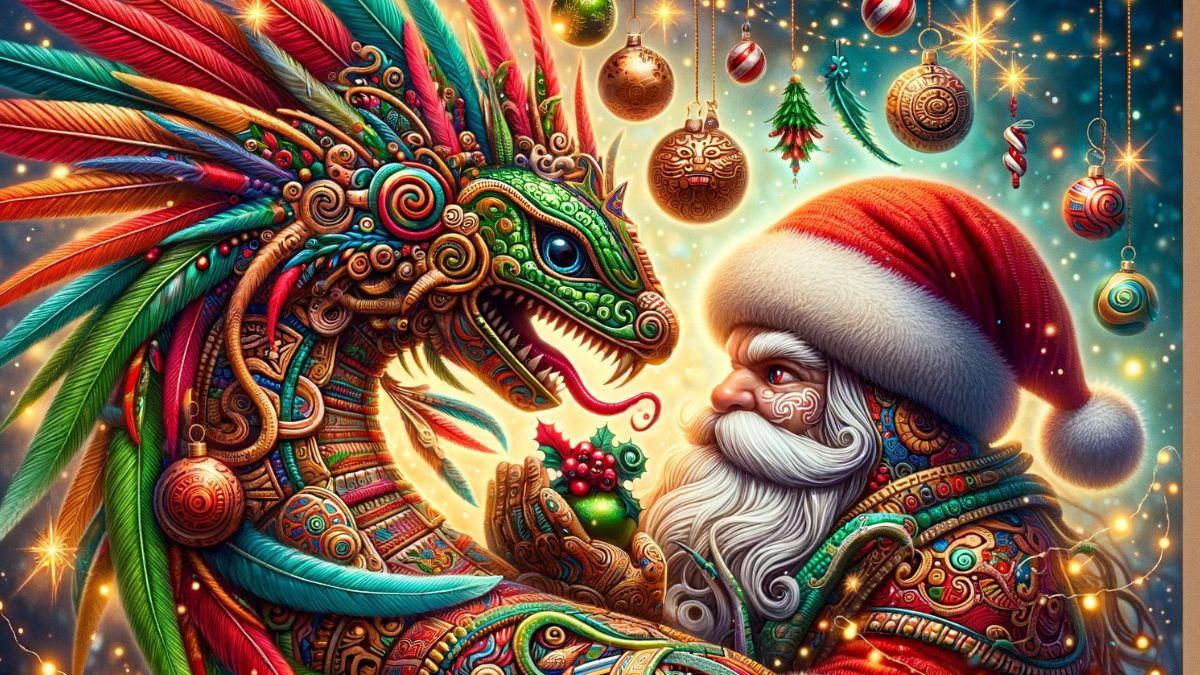The mission was singular: to banish Santa Claus and nationalize Christmas. It was 1930 in Mexico, and the air buzzed with a nationalist spirit driven by President Pascual Ortiz Rubio. In his quest to promote Mexican culture, Ortiz Rubio made a bold decision: it was time for Christmas in Mexico to have its own emblematic figure, one that resonated with the country’s identity. The choice fell on Quetzalcoatl, the feathered serpent, a god of Mesoamerican culture, symbolizing wisdom, light, and renewal.
On December 23, 1930, Mexico City witnessed an unprecedented event at the National Stadium. Thousands, including countless children, gathered to see the introduction of Quetzalcoatl as the new Christmas icon.
A man dressed as the Mesoamerican god appeared in a majestic temple adorned with elements of Mexican culture, distributing gifts among the children.
Failed attempt: The banishment of Santa Claus
However, the idea of replacing Santa Claus with Quetzalcoatl did not deeply resonate with all Mexicans. For some, Santa Claus embodied a more universal Christmas spirit, transcending borders and cultures. For others, the concept of a god like Quetzalcoatl as a symbol of Christmas simply did not permeate.
It was illogical to ask an overwhelmed pre-Hispanic god to become a festive element of Catholicism’s most important holiday, a religion that devastated his world.
The story of Quetzalcoatl’s attempt to replace Santa Claus in Mexico holds an ironic analogy to the plot of Tim Burton’s masterpiece “The Nightmare Before Christmas.” In this film, Jack Skellington, the king of Halloween Town, captivated by the joy and color of Christmas, decides to kidnap Santa Claus and take his place, believing he can do it better.
Unlike Jack, Quetzalcoatl was imposed and presented as a new protagonist for a festival foreign to his origin, in an attempt to merge two very different cultures. Both figures, although from different worlds, sought to inject their own style and vision into an established tradition, believing they could improve it or give it new meaning.
In the end, Quetzalcoatl failed in the attempt to become a Mexican Christmas symbol.
Historian Alejandro Rosas recounts this in an article published on WikiMéxico:
“The society completely opposed the official disposition; not so much to defend the already unlikable Santa Claus, but because Christmas was a Catholic celebration commemorating the birth of Christ, and if within that tradition, Saint Nicholas already figured, there was no reason to make changes.”
Branding lessons with Quetzalcoatl and Santa Claus
The attempt to impose Quetzalcoatl as the symbol of Christmas has interesting implications for marketing and branding.
Reflecting on this episode from a marketing and branding perspective underscores the importance of identity and cultural relevance in promoting brands and symbols.
The attempt to establish Quetzalcoatl as the Christmas emblem was more than a political move; it represented an effort to impose a Mexican cultural identity in an era where the motto was to banish any foreign influence at all costs, in this case, Christmas personified in Santa Claus.
For a major brand, this episode offers valuable lessons. First, it underlines the importance of aligning marketing campaigns with the values and culture of the target audience. In a globalized world, respecting and celebrating local cultural identity can be a key differentiator.
Second, it shows the risks of underestimating established emotions and connections. Perhaps Mexicans’ bond with Santa Claus wasn’t very strong in 1930 (consider a country without Coca Cola Caravans). But the myth of Quetzalcoatl was not the symbol that the predominantly Catholic population could associate with Christmas. (Imagine now a nativity scene, the figures of the birth, all crowned with the figure of a feathered serpent…).
Brands cannot always impose their own symbols and values on consumers. Consumers are free to choose the brands they like, and often are drawn to brands that reflect their own identities and values.
Another important lesson from this episode: brands can coexist successfully, even if they represent different values. In the case of Quetzalcoatl and Santa Claus, both figures are symbols, but they represent different cultures and traditions. However, both figures can coexist in the same culture, without the need for one to dominate over the other.
The story of Quetzalcoatl and Santa Claus in Mexico is not just a tale of a failed symbolic change attempt. It is a testament to the resilience and adaptability of cultural traditions.
Smart brands are aware of these implications. They know that consumers are free to choose, and that they must reflect the values of consumers to be successful. They also know that they can coexist successfully, evolve, and adapt over time.












